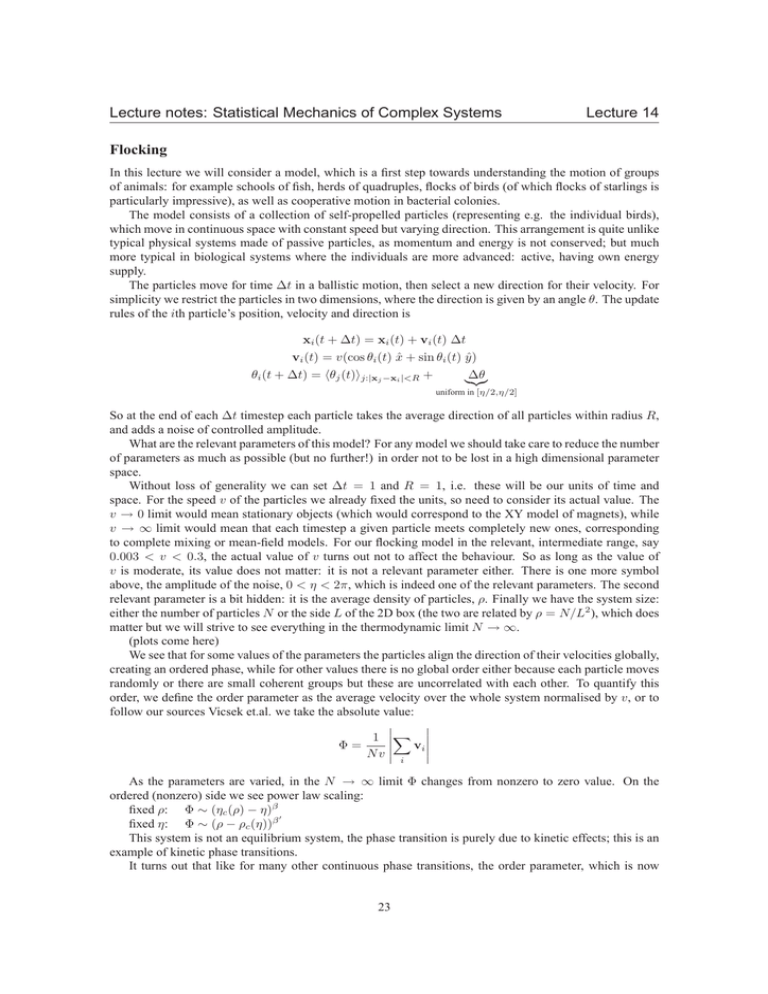Lecture notes: Statistical Mechanics of Complex Systems Lecture 14 Flocking
advertisement

Lecture notes: Statistical Mechanics of Complex Systems
Lecture 14
Flocking
In this lecture we will consider a model, which is a first step towards understanding the motion of groups
of animals: for example schools of fish, herds of quadruples, flocks of birds (of which flocks of starlings is
particularly impressive), as well as cooperative motion in bacterial colonies.
The model consists of a collection of self-propelled particles (representing e.g. the individual birds),
which move in continuous space with constant speed but varying direction. This arrangement is quite unlike
typical physical systems made of passive particles, as momentum and energy is not conserved; but much
more typical in biological systems where the individuals are more advanced: active, having own energy
supply.
The particles move for time ∆t in a ballistic motion, then select a new direction for their velocity. For
simplicity we restrict the particles in two dimensions, where the direction is given by an angle θ. The update
rules of the ith particle’s position, velocity and direction is
xi (t + ∆t) = xi (t) + vi (t) ∆t
vi (t) = v(cos θi (t) x̂ + sin θi (t) ŷ)
θi (t + ∆t) = hθj (t)ij:|xj −xi |<R +
∆θ
|{z}
uniform in [η/2,η/2]
So at the end of each ∆t timestep each particle takes the average direction of all particles within radius R,
and adds a noise of controlled amplitude.
What are the relevant parameters of this model? For any model we should take care to reduce the number
of parameters as much as possible (but no further!) in order not to be lost in a high dimensional parameter
space.
Without loss of generality we can set ∆t = 1 and R = 1, i.e. these will be our units of time and
space. For the speed v of the particles we already fixed the units, so need to consider its actual value. The
v → 0 limit would mean stationary objects (which would correspond to the XY model of magnets), while
v → ∞ limit would mean that each timestep a given particle meets completely new ones, corresponding
to complete mixing or mean-field models. For our flocking model in the relevant, intermediate range, say
0.003 < v < 0.3, the actual value of v turns out not to affect the behaviour. So as long as the value of
v is moderate, its value does not matter: it is not a relevant parameter either. There is one more symbol
above, the amplitude of the noise, 0 < η < 2π, which is indeed one of the relevant parameters. The second
relevant parameter is a bit hidden: it is the average density of particles, ρ. Finally we have the system size:
either the number of particles N or the side L of the 2D box (the two are related by ρ = N/L2 ), which does
matter but we will strive to see everything in the thermodynamic limit N → ∞.
(plots come here)
We see that for some values of the parameters the particles align the direction of their velocities globally,
creating an ordered phase, while for other values there is no global order either because each particle moves
randomly or there are small coherent groups but these are uncorrelated with each other. To quantify this
order, we define the order parameter as the average velocity over the whole system normalised by v, or to
follow our sources Vicsek et.al. we take the absolute value:
1 X Φ=
vi Nv i
As the parameters are varied, in the N → ∞ limit Φ changes from nonzero to zero value. On the
ordered (nonzero) side we see power law scaling:
fixed ρ: Φ ∼ (ηc (ρ) − η)β
′
fixed η: Φ ∼ (ρ − ρc (η))β
This system is not an equilibrium system, the phase transition is purely due to kinetic effects; this is an
example of kinetic phase transitions.
It turns out that like for many other continuous phase transitions, the order parameter, which is now
23
Lecture notes: Statistical Mechanics of Complex Systems
Lecture 14
function of two parameters Φ(η, ρ), can in fact be written as a scaling function of as single variable:
(
(1 − u)β , if u < 1
η
,
Φ̃(u) ∼
Φ(η, ρ) = Φ̃
ηc (ρ)
0
if u > 1
With the help of the scaling function we can now look at the scaling exponents β and β ′ . For fixed η
′
and varying ρ, we defined β ′ as Φ ∼ (ρ − ρc (η))β . Denoting ǫ = ρ − ρc (η):
Φ(η, ρc (η) + ǫ) = Φ̃
η
ηc (ρc (η) + ǫ)
≈ Φ̃
η
c
η + ǫ dη
dρ ρ=ρc (η)
ǫ dηc
∼ ǫβ
≈ Φ̃ 1 −
η dρ
so we have shown that β = β ′ , despite the original different numerical estimates.
There is current ongoing research (as of 2010-2011) on the dynamics of flocks of starlings in Italy. The
current understanding is that while the above model is a good starting point, real birds don’t really consider
a fixed radius neighborhood, but instead watch a fixed number of neighbors and keep them oriented by
trying to maintain relative angles between them fixed.
24




